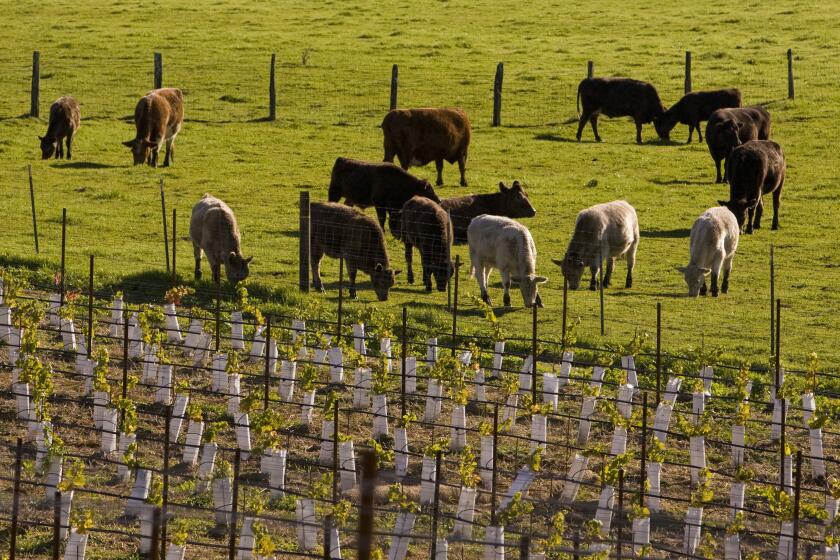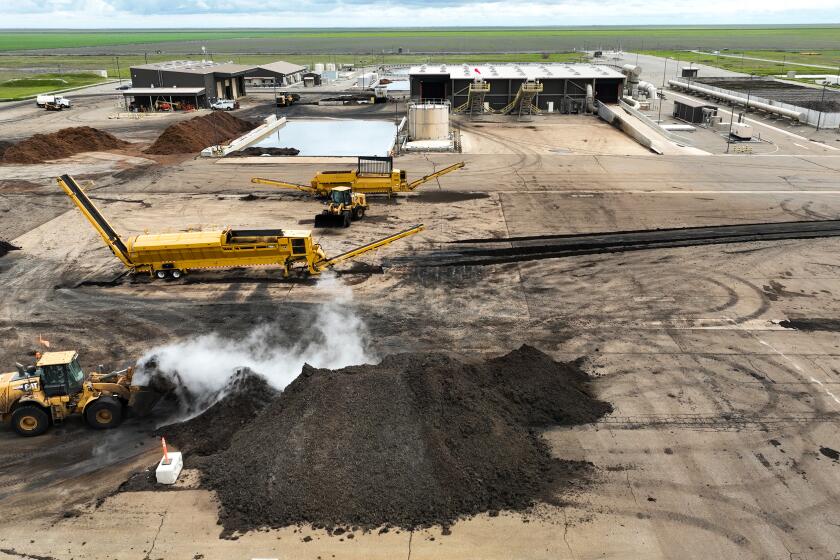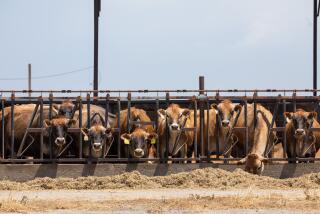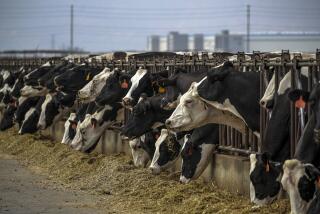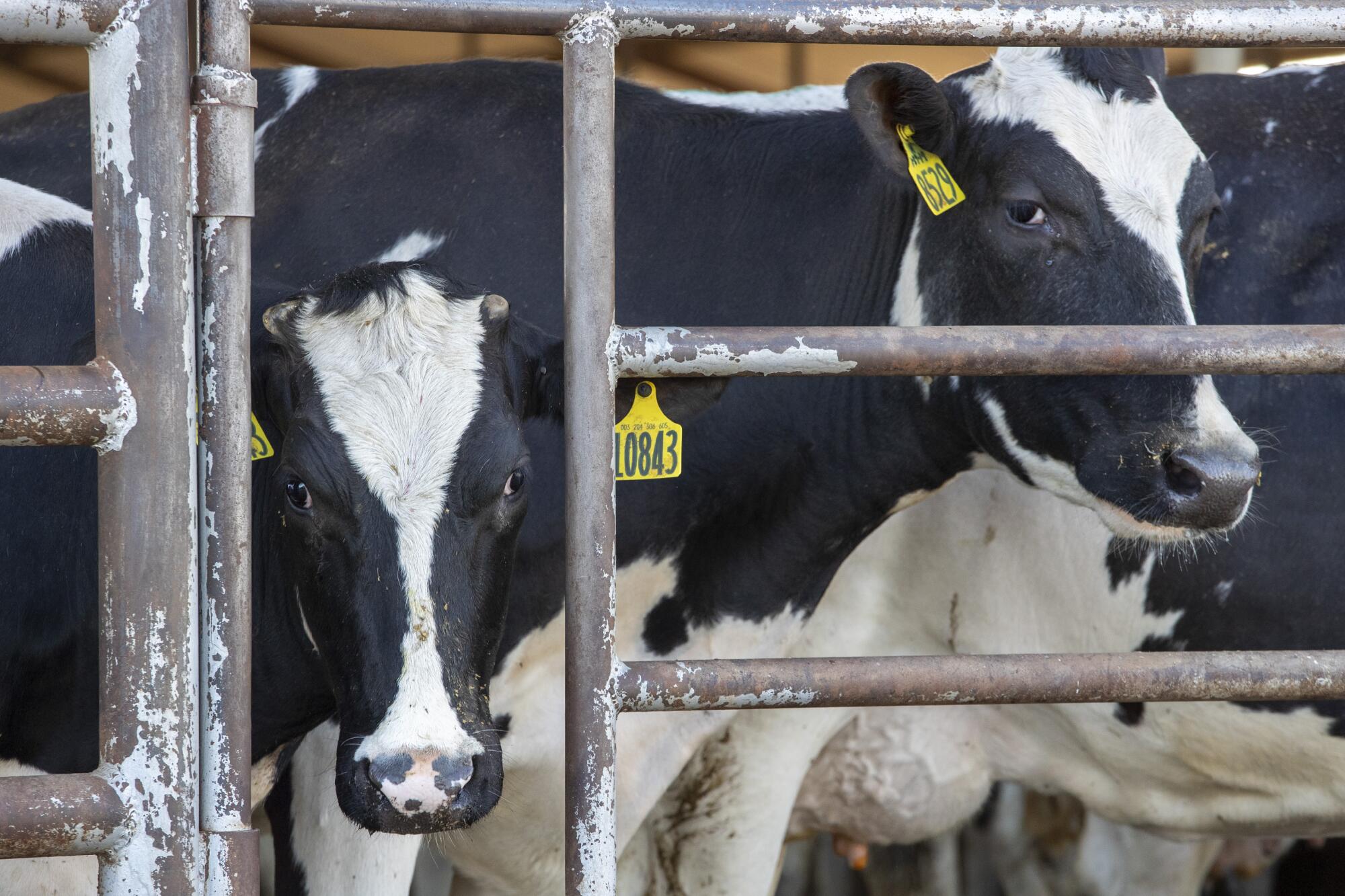
- Share via
Earlier this spring, dairy farmers noted a puzzling drop in milk production in Texas, New Mexico, Idaho, Ohio, Kansas and Michigan. Weeks later, news broke that several herds in these states, as well as North Carolina, had been diagnosed with avian influenza — the same strain that has devastated bird populations across the globe and shown a troubling ability to jump to mammals.
In an effort to prevent local herds from infection, officials in California and elsewhere have imposed restrictions on cattle imports from the affected states, while the U.S. Department of Agriculture has urged livestock managers to minimize the movement of cattle as much as possible.
Although the U.S. Centers for Disease Control and Prevention believes the current risk to the general public is low, the development has left dairy farmers reeling. Never before have U.S. dairy cows been infected with H5N1 bird flu viruses.
“Nobody saw this coming,” said Michael Payne, a researcher and outreach coordinator at the Western Institute for Food Safety and Security at UC Davis.
What is driving the unprecedented spread of avian flu?
Scientists and health agencies across the globe have been tracking the spread of the virus for years.
Since 2021, it has killed hundreds of millions of farmed poultry and infected more than 48 species of mammals — including humans — as well as countless numbers of wild birds. It has also proved especially deadly among some communal mammals, such as elephant seals and sea lions in South America, as well as caged fur-farmed animals in Europe.
Nevertheless, outbreaks among dairy cows have come as a rude shock.
In addition to the cattle infections, a farmworker in Texas who was in close contact with infected dairy cows also became infected, but experienced only mild symptoms. This was the second known human case in the United States.
Despite the mildness of the farmworker’s illness, the prospect of continued infections worries some.
“The concerning trend of multiple states reporting cattle infections raises the likelihood of continued human exposure,” said Suresh Kuchipudi, professor and chair of the University of Pittsburgh’s department of infectious diseases and microbiology. “This could amplify the risk of further virus adaptation, potentially facilitating human-to-human transmission.”
Public health advocates, wildlife biologists and epidemiologists say there are a few reasons that the cattle outbreaks have surprised farmers and officials.
First, although there have been sporadic infections of cattle via other flu strains in the past, no other avian flu has ever evolved the ability to pass between cows and other ruminants, Kuchipudi said.
“That was surprising,” he said. “Totally unprecedented.”
Animal rights activists are promoting a ballot initiative that would ban factory farming in Sonoma County. Large farming interests are not happy.
And second, there is no single federal or state agency responsible for following this disease — one that affects wildlife, agriculture and public health. Some experts say it’s a flawed silo-like approach for a virus that concerns multiple government agencies here and in other nations.
“This is a fundamental problem in our monitoring system, especially when it comes to emerging and zoonotic infections, such as the avian flu,” Kuchipudi said. “This is a public health problem, a wildlife problem and also a domestic animal problem,” for which a so-called One Health approach — in which all three elements are included — could really help in terms of managing information collection and communication.
For instance, although it’s still unclear how the cows got the disease, if farmers had been on the lookout for sick birds or wildlife and been communicating with wildlife agencies and their farm bureaus, the infection might have been contained, experts say.
California’s Department of Food and Agriculture is now asking farmers to be on the lookout for sick birds and mammals, and to take steps to humanely remove migrating birds and waterfowl that could come into contact with their herds, and prevent them from nesting nearby.
There is also a concern that the disease was passed via infected poultry litter — a mix of poultry excreta, spilled feed, feathers, and other waste scraped from the floors of industrial chicken and turkey production plants — which, in the United States, is used in cattle feed on some farms. UC Davis’ Payne said that in California, poultry waste is processed at high virus-killing temperatures, so it is unlikely to be a concern.
The practice is banned in the United Kingdom, European Union and Canada, where fears of spreading bovine spongiform encephalitis — mad cow disease — made such practices seem too risky.
Despite concerns voiced by some experts, California officials say existing bird flu monitoring efforts are effective.
State Veterinarian Annette Jones said that she works with multiple state and federal agencies, such as the U.S. Department of Agriculture.
“We have veterinarians and experts spread throughout the state that can do those initial investigations. And if there’s any inkling that there could be a human health issue, then we also work very closely with the California Department of Public Health, who has links to county public health [agencies] and [the] CDC,” she said. “To the outside person that seems probably like acronym soup, right? But to an inside person with experience, we know.”
Jones and others in the dairy and agricultural sector say there is no reason for the public to be alarmed or concerned when it comes to avian flu-infected cattle.
They say infected cows seem to have a mild reaction and get better quickly. Also, milk is pasteurized, so if an infected cow’s milk were to get into the system, the virus would be killed.
But others say it’s the “what’s next” question that is most worrying.
California winds spread microplastics from natural fertilizers at higher concentrations than previously known, a team of UCLA researchers has found.
“We want to address what is happening so that we can prevent something worse from happening,” said J. Scott Weese, a professor at the Ontario Veterinary College and director of the University of Guelph’s Center for Public Health and Zoonoses. “That something worse is this virus becoming a virus that can be easily transmitted between humans and can cause serious disease.”
The disease has already bucked all expectations — such as its ability to infect a variety of species as well as its international reach and duration, experts say. That should make its appearance on a mammal-based factory farm a cause for doubled-down surveillance and concern, said Crystal Heath, a San Francisco Bay Area veterinarian and co-founder of Our Honor, an animal welfare organization.
“You have hundreds, if not thousands, of genetically similar animals all living in the same space, standing in each others’ waste and breathing on each other,” Heath said. “Its Shangri-La for an opportunistic virus.”
And it is still unclear how widespread the virus is, or how long it’s been infecting cattle, Weese said.
The fact that observers had noticed a drop in milk production in states now known to have infected herds suggests that it may have been around for weeks or months. And if symptoms were mild enough in cattle and humans not to warrant a vet or doctor’s visit, it could be circulating and getting even more chances to evolve, said Weese — including finding a mammalian host with a human and avian flu, allowing an opportunity to mix and recombine.
Which is why many are now looking toward factory pigs and swine, said Matthew Hayek, assistant professor of environmental studies at New York University . Pigs are considered effective and worrisome flu-recombination factories — mammalian vessels that mix human and bird flu viruses with potentially lethal ease.
“That’s a problem not just for the sake of our food production,” he said, “but for the sake of our safety as a species.”
Toward a more sustainable California
Get Boiling Point, our newsletter exploring climate change, energy and the environment, and become part of the conversation — and the solution.
You may occasionally receive promotional content from the Los Angeles Times.

